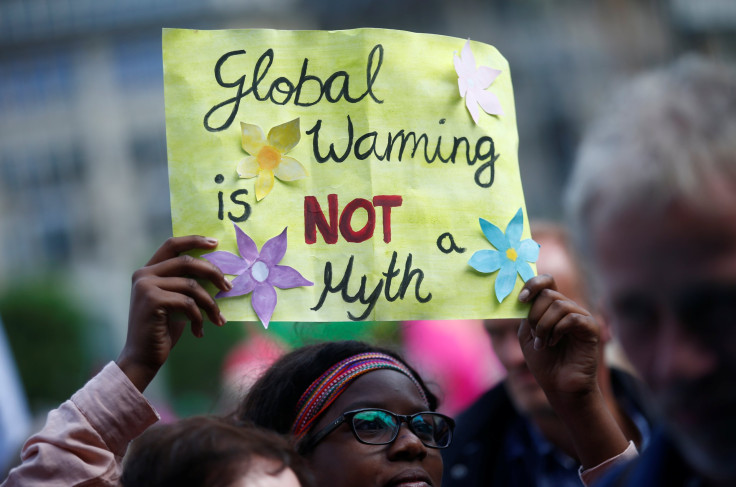Global Warming By 2 Degrees Unavoidable By 2100, 2 Studies Find

Two separate studies published online Monday in the journal Nature Climate Change found Earth will be warmer by at least 2 degrees by the year 2100. The main difference between the two analyses of climate change was that one used Fahrenheit and the other Celsius to predict the rise in global temperatures.
One study, led by researchers from University of Washington (UW), used statistical tools and concluded there was “only a 5 percent chance that Earth will warm 2 degrees [Celsius] or less by the end of this century. It shows a mere 1 percent chance that warming could be at or below 1.5 degrees [Celsius], the target set by the 2016 Paris Agreement.”
Read: Global Warming By 2250 Could Make Earth Warmer Than It Has Been In 400 Million Years
UW’s Adrian Raftery, who led the research for the new paper, said in a statement Monday the 2 degree Celsius rise was a best-case scenario which was achievable only if there was a concerted and massive effort across all fronts to achieve that goal for the next 80 years. The researchers’ analysis shows an overwhelming 90 percent chance of temperatures going up by anywhere between 2 and 4.9 degrees Celsius by 2100.
“Our analysis is compatible with previous estimates, but it finds that the most optimistic projections are unlikely to happen. We’re closer to the margin than we think,” Raftery said in the statement.
For their projections, the researchers used three factors that affect future emissions: the total human population of the planet, gross domestic product per person, and carbon intensity, which is a measure of carbon emission for each dollar of economic activity. Statistical projections were made on the basis of data for the last 50 years.
Earth’s population is expected to reach 11 billion by the year 2100, according to the projections, an almost 50 percent increase from the current world population. But since most of this growth is expected to come from Africa, where fossil fuel consumption is low, the researchers found this factor to be only a minor one in their projections.
The biggest factor was found to be carbon intensity, which has been dropping in recent years due to increased energy efficiency across industries. But the study found “a wide range of possible values of carbon intensity over future decades, depending on technological progress and countries’ commitments to implementing changes.”
Based on various projections, the study, titled “Less than 2 °C warming by 2100 unlikely,” found a median value of 3.2 degrees Celsius for global temperature rise by 2100.
Read: Global Warming Causing More Storms That Threaten Birds’ Migration
The other study, titled “Committed warming inferred from observations,” was authored by Robert Pincus of University of Colorado, Boulder, and Thorsten Mauritsen from Max Planck Institute for Meteorology in Hamburg, Germany. And it said even if we somehow stopped all greenhouse gas emissions in 2017, the Earth would still heat up by about 2.3 degrees Fahrenheit (1.3 degrees Celsius) by the turn of the century.
If emissions continue at the current pace for another 15 years, there is a high chance it will lead to a 3 degrees Fahrenheit temperature rise, according to the study. It also said “there is a 13 percent chance we are already committed” to a rise of 3 degrees Fahrenheit by 2100, irrespective of future emissions.
“This ‘committed warming’ is critical to understand because it can tell us and policymakers how long we have, at current emission rates, before the planet will warm to certain thresholds. The window of opportunity on a 1.5-degree [Celsius] target is closing,” Pincus said in a statement on the university’s website Monday.
The only bright spot, if it can be called that, in their predictions is that carbon absorption by oceans could reduce the temperature rise somewhat. Natural capture of carbon by the oceans and its storage in the deep could reduce the “committed warming” by about 0.4 degrees Fahrenheit.
“Our estimates are based on things that have already happened, things we can observe, and they point to the part of future warming that is already committed to by past emissions,” Mauritsen said in the statement. "Future carbon dioxide emissions will then add extra warming on top of that commitment.”
The human cost of climate change will be no small number by the year 2100. According to another study published Monday in the same journal, researchers from the University of North Carolina at Chapel Hill said in a statement that global air pollution caused by climate change, if not addressed, is likely to cause 60,000 deaths around the world by 2030. And that number will climb over four-fold to 260,000 deaths globally by 2100.
© Copyright IBTimes 2024. All rights reserved.




















